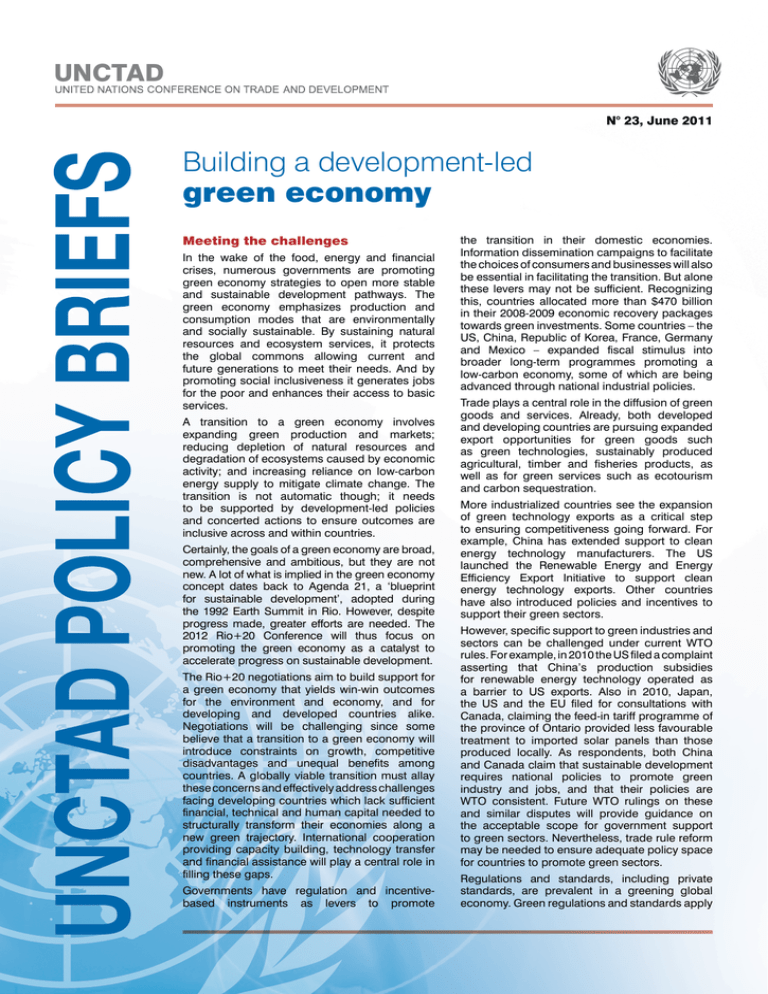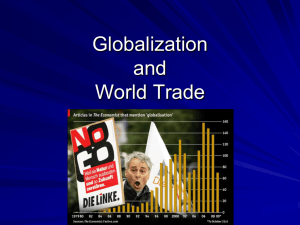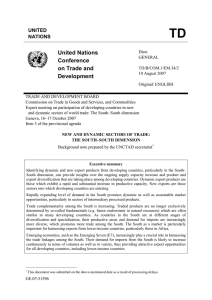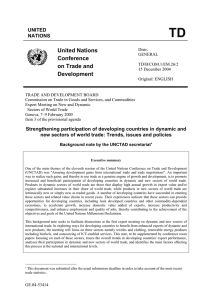Building a development-led green economy UNCTAD N° 23, June 2011
advertisement

UNCTAD N° 23, June 2011 Building a development-led green economy Meeting the challenges In the wake of the food, energy and financial crises, numerous governments are promoting green economy strategies to open more stable and sustainable development pathways. The green economy emphasizes production and consumption modes that are environmentally and socially sustainable. By sustaining natural resources and ecosystem services, it protects the global commons allowing current and future generations to meet their needs. And by promoting social inclusiveness it generates jobs for the poor and enhances their access to basic services. A transition to a green economy involves expanding green production and markets; reducing depletion of natural resources and degradation of ecosystems caused by economic activity; and increasing reliance on low-carbon energy supply to mitigate climate change. The transition is not automatic though; it needs to be supported by development-led policies and concerted actions to ensure outcomes are inclusive across and within countries. Certainly, the goals of a green economy are broad, comprehensive and ambitious, but they are not new. A lot of what is implied in the green economy concept dates back to Agenda 21, a ‘blueprint for sustainable development’, adopted during the 1992 Earth Summit in Rio. However, despite progress made, greater efforts are needed. The 2012 Rio+20 Conference will thus focus on promoting the green economy as a catalyst to accelerate progress on sustainable development. The Rio+20 negotiations aim to build support for a green economy that yields win-win outcomes for the environment and economy, and for developing and developed countries alike. Negotiations will be challenging since some believe that a transition to a green economy will introduce constraints on growth, competitive disadvantages and unequal benefits among countries. A globally viable transition must allay these concerns and effectively address challenges facing developing countries which lack sufficient financial, technical and human capital needed to structurally transform their economies along a new green trajectory. International cooperation providing capacity building, technology transfer and financial assistance will play a central role in filling these gaps. Governments have regulation and incentivebased instruments as levers to promote the transition in their domestic economies. Information dissemination campaigns to facilitate the choices of consumers and businesses will also be essential in facilitating the transition. But alone these levers may not be sufficient. Recognizing this, countries allocated more than $470 billion in their 2008-2009 economic recovery packages towards green investments. Some countries – the US, China, Republic of Korea, France, Germany and Mexico – expanded fiscal stimulus into broader long-term programmes promoting a low-carbon economy, some of which are being advanced through national industrial policies. Trade plays a central role in the diffusion of green goods and services. Already, both developed and developing countries are pursuing expanded export opportunities for green goods such as green technologies, sustainably produced agricultural, timber and fisheries products, as well as for green services such as ecotourism and carbon sequestration. More industrialized countries see the expansion of green technology exports as a critical step to ensuring competitiveness going forward. For example, China has extended support to clean energy technology manufacturers. The US launched the Renewable Energy and Energy Efficiency Export Initiative to support clean energy technology exports. Other countries have also introduced policies and incentives to support their green sectors. However, specific support to green industries and sectors can be challenged under current WTO rules. For example, in 2010 the US filed a complaint asserting that China’s production subsidies for renewable energy technology operated as a barrier to US exports. Also in 2010, Japan, the US and the EU filed for consultations with Canada, claiming the feed-in tariff programme of the province of Ontario provided less favourable treatment to imported solar panels than those produced locally. As respondents, both China and Canada claim that sustainable development requires national policies to promote green industry and jobs, and that their policies are WTO consistent. Future WTO rulings on these and similar disputes will provide guidance on the acceptable scope for government support to green sectors. Nevertheless, trade rule reform may be needed to ensure adequate policy space for countries to promote green sectors. Regulations and standards, including private standards, are prevalent in a greening global economy. Green regulations and standards apply UNCTAD Seizing new trade opportunities A green economy is driven by both domestic and foreign demand for green goods and services, including more efficient and low-carbon energy systems, organic food, ecotourism, solid waste and water recycling, environmental consulting, and emerging categories that include green construction, sustainable harvested timber products, electric bicycles and hybrid cars. Many green categories represent just a small fraction of their ‘brown’ counterparts indicating a vast potential for growth. Whether in high-tech goods, commodities, basic manufactures or services, the export opportunities offered in a greening global economy are significant and expanding faster than overall world trade; a trend that is expected to continue. The global market in low-carbon and energy efficient technologies is projected to nearly triple to $2.2 trillion in 2020. The supply-side response to this burgeoning market has been significant, with a rapid ramping-up of production and export capacity in a handful of developing countries, in some cases facilitated by foreign investment and technology transfer by multinational companies, as well as national industrial policies targeting green sectors. Renewable energy technologies such as solar panels and wind turbines, and energy efficient products such as compact fluorescent lamps are among the green technologies seeing the sharpest rise in exports. Developing countries have made significant progress in supplying global markets for these products; their share of world exports increased from 24 percent in 2002 to 50 percent in 2009, generating export revenues of $22 billion in 2009. But relatively few developing countries are participating in this trend. Only six developing economies – China, Taiwan Province of China, India, Republic of Korea, Malaysia and Singapore – account for over 90 percent of developing countries’ exports of this group of products. And although exports by countries such as Brazil, Mexico, Philippines, South Africa, Turkey and Vietnam are growing, exports from most other developing countries remain minimal or entirely absent. However, green technologies are often produced in developed and more industrialized developing countries using intermediate inputs originating from a wide variety of developing countries that are integrated in global supply chains. Trade in intermediate goods, which accounts for about 40 percent of world merchandise trade, is thus an important entry point for developing countries to supply green markets. Participation in supply chains generates economy-wide gains, such as employment, improvement in technology and skills, productive capacity upgrading, and diversification into valueadded exports. While businesses in more industrialized developing countries are seizing new export opportunities for green technologies, businesses in less industrialized developing countries continue to build their export capacities for green products such as organic food and beverages, natural cosmetics and fibres, biofuels, and sustainably harvested timber and fisheries products, and for green services such as ecotourism. In each of these sectors developing country exports are experiencing sharp growth, generating employment, advancing rural development and protecting the environment. The global market for organic food and beverage products is projected to reach $60 billion this year; a more than three-fold expansion from 2000 levels. Organic farming is practiced on 37 million hectares in 160 countries; a nearly four-fold increase over the past decade. Increases in organic farmland are occurring predominantly in developing countries to respond to growth in demand in Northern markets. About 75 percent of the more than 1.8 million producers worldwide are farmers in over 110 developing countries, with the largest numbers in India, Uganda, Mexico, Ethiopia, Tanzania, Peru, Turkey and Burkina Faso. Consumer preferences for natural fibres such as organic cotton, wool, hemp and silk used in textiles, and natural oils, waxes, fats and herbs used in cosmetics, are providing new income opportunities in the South. These and other biotrade products are important exports for many developing countries. In Latin America alone, biotrade exports generated over $230 million in 2008. Biofuels are also a growing export commodity for developing countries which account for over 40 percent of world bioethanol production and 12 percent of world biodiesel production. Top producers are Brazil, China, India, Colombia, Republic of Korea, Thailand and Malaysia. Developing countries are also increasing their presence in sustainably harvested timber products markets. Globally, forest land area certified by the Forest Stewardship Council increased seven-fold over the past decade to reach nearly 140 million hectares in 2010 with developing countries’ share of this total rising to about 20 percent. Sustainably harvested fish is another growing export of developing countries which account for 50 percent of global fish exports with net export revenues exceeding $25 billion. Green services represent additional export opportunities for developing countries. Ecotourism is projected to capture 25 percent of global tourism revenues in 2012, with international tourists spending $240 billion in ecotourism destinations. The majority of these destinations are in developing countries such as Brazil, UAE, Belize, Kenya, Gabon, Botswana, Costa Rica, Laos, Nepal and Palau. Carbon sequestration is another area where developing countries are exporting green services, including through international mechanisms such as CDM and REDD. Through its research and country-based activities UNCTAD supports national reviews of economic, regulatory, institutional and trade policy factors related to enhancing productive capacities in green sectors. Further information and background material on issues addressed in this policy brief are available on UNCTAD’s website: www.unctad.org/ greeneconomy or by contacting UNCTAD at greeneconomy@ unctad.org. + 4 1 2 2 9 1 7 5 8 2 8 – u n c t a d p r e s s @ u n c t a d . o r g – w w w . u n c t a d . o r g unctad/press/PB/2011/11 (N° 23) not only to green products, but more broadly to all goods and services through efforts to integrate green production, packaging, transportation, distribution and recycling into global supply chains. When pioneering green regulation is introduced in the world’s largest market, it is bound to impact other countries through trade. Companies exporting to the EU manufacture their products to meet stringent EU standards. At the same time, similar environmental regulations are emerging across the world. This trend points to the importance of harmonizing standards and raising the capacity of developing country businesses to integrate green requirements into their operations to facilitate their participation in a greening global economy.








